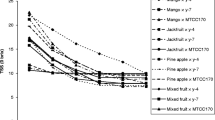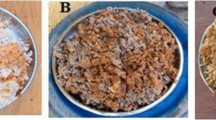Abstract
The study focused on the production of wine from date palm fruits (Phoenix dactylifera L.) using a strain of yeast isolated from selected Nigerian locally fermented beverages (‘pito’, ‘brukutu’ and palm wine). Seven (7) distinct yeasts were isolated and identified using cultural, microscopy and biochemical tests (temperature tolerance, flocculation, ethanol tolerance, H2S production and killer toxin production and the ability to assimilate and ferment sugars. The yeast isolates were screened using refractometric and spectrophotometric methods to select the isolate with the best ability for wine production. This isolate was molecularly characterized, grown in 1 L of potatoes dextrose broth, freeze dried and used for wine production. The population of yeast, bacteria and the physicochemical analysis of the must were monitored during fermentation. Populations of bacteria in the wine were assessed by standard pour plate count. The proximate content and physicochemical properties of the produced wine before and after ageing, as well as the sensorial quality of the produced wine was determined. All the yeast isolates possessed the ability to flocculate, tolerate ethanol concentration of between 5 and 20% and temperature range of 30–45 °C, produced low concentration of H2S and does not produce killer toxins. A palm wine isolate, identified as Saccharomyces cerevisiae X01 was selected as the best isolate with the most ability for wine production. The total yeast count increases as the period of fermentation progressed while the total viable bacterial count reduced as the fermentation period progressed. There was a significant difference (P < 0.05) in the physicochemical properties of the must during fermentation. At the end of the fermentation, the produced wine had 5.22% and 4.86% ethanol content for S. cerevisiae QA23 and S. cerevisiae X01 respectively. There was no significant difference (P > 0.05) between the proximate and physicochemical compositions of the produced wine before and after ageing using Saccharomyces cerevisiae X01 when compared to the control S. cerevisiae QA23. This study revealed that the Nigerian locally sourced S. cerevisiae X01 can be used as an alternative substrate for industrial scale production of wine with a mild alcoholic content.




Similar content being viewed by others
References
Adeleke RO, Abiodun OA (2010) Physicochemical properties of commercial local beverages in Osun State Nigeria. Pak J Nutr 9(9):853–855
AOAC (2000) Official methods of analysis of the AOAC, 18th edn. Author, Washington
Awe S (2011) Production and microbiology of pawpaw (Carica papaya) wine. Curr Res J Biol Sci 3(5):443–447
Awe S, Nnadoze SN (2015) Production and microbiological assessment of date palm (Phoenix dactylifera L.) fruit wine. Br Microbiol Res J 8(3):480–488
Balarabe MM, Mohammed SSD, Orukotan AA (2017) Screening of fermentative potency of yeast isolates from indigenous sources for dough leavening. Int J Microbiol Biotechnol 2(1):12–17
Balogu TV, Towobola O (2017) Production and quality analysis of wine from honey and coconut milk blend using Saccharomyces cerevisiae. Fermentation 3(2):16
Bankefa EO, Oyedeji OM (2015) Synergistic fermentative nutritional quality of Lactobacillus delbrueckii and Bacillus pumilus on date fruits (Phoenix dactylifera). Afr J Food Sci 9(5):307–313
Barnett JA, Payne RW, Yarrow D (1990) Yeast: characteristics and identification, 2nd edn. Cambridge University Press, Cambridge
Castillo-Castillo Y, Ruiz-Barrera O, Burrola-Barraza ME, Marrero-Rodriguez Y, Salinas-Chavira J, Angulo-Montoya C, Corral-Luna A, Arzola-Alvarez C, Itza-Ortiz M, Camarillo J (2016) Isolation and characterization of yeasts from fermented apple bagasse as additives for ruminant feeding. Braz J Microbiol 47:889–895
Danmadami RN, Yabaya A, Yahaya O, Abraham OJ, Bobai M, Orukotan AA (2017) The efficiency of Saccahromyces cerevisiae strain isolated from palm wine in the production of ‘burukutu’. Int J Res 5(11):70–85
Garba MD, Galadima A (2012) Anti-diarrhoea and phytochemical evaluation of Phoniex dactylifera L. extracts. Elixir Appl Chem 49:9808–9812
Gidado RSM, Olatiilu OA, Etuk-Udo GA, Onyenekwe PC, Isu RN, Habu J (2016) Isolation and characterization of yeast inhabiting alcohol processing environment in Bayelsa state, Nigeria. Adv Appl Sci 1(3):78–85
Guizani N, Al-Saidi GS, Rahman MS, Bornaz S, Al-Alawi AA (2010) State diagram of dates: glass transition, freezing curves and maximal-freeze- concentration condition. J Food Eng 99:92–97
Hong KK, Nielsen J (2012) Metabolic engineering of Saccharomyces cerevisiae: a key cell factory platform for future biorefineries. Cell Mol Life Sci 69:2671–2690
Johnson DV (2012) Enhancement of date palm as a source of multiple products: examples from other industrialized palms. Emir J Food Agric 24(5):408–414
Johnson EA (2013) Biotechnology of non-Saccharomyces yeasts: the Ascomycetes. Appl Microbiol Biotechnol 97:503–517
Martínez JL, Liu L, Petranıvic D, Nielsen J (2012) Pharmaceutical protein production by yeast: towards production of human blood proteins by microbial fermentation. Curr Opin Biotechnol 23:965–971
Mohammed SSD, Yohanna B, Wartu JR, Abubakar NL, Bello S (2018) Wine produced from fermentation of honey slurry and dates palm fruit juice blend using Saccharomyces cerevisiae isolated from palm wine. Int J Biol 10(3):53–61
Nwaokobia KR, Ogboru O, Idibie CA (2018) Investigating the proximate, ultimate and chemical composition of four cultivars of date seed, Phoenix dactylifera L. World News Nat Sci 18(2):52–61
Olowonibi OO (2017) Isolation and characterization of palm wine strains of Saccharomyces cerevisiae potentially useful as bakery yeasts. Eur J Exp Biol 7(11):1–13
Tsegaye Z, Tefera G, Gizaw B, Abatenh E (2018) Characterization of yeast species isolated from local fruits used for bakery industrial application. J Appl Microbiol Res 1(1):17–26
Ukponobong EA, Otobong DA, Nsikak U, Stephen CK, Nseobong GA (2018) Isolation and screening of yeast isolates indigenous palm wine for ethanol production. Philipp J Sci 147(3):411–417
Valdineia AO, Maristela AV, Luciano GF, Ieso-de-Miranda C, Maurıcio XC, Dorit S, Henrique A, Margarida C, Juliana-de-Oliveira S, Leandro DA, Paulo HA, Rogelio LB (2008) Biochemical and molecular characterization of Saccharomyces cerevisiae strains obtained from sugar-cane juice fermentations and their impact in cachaca production. Appl Environ Microbiol 74(3):693–701
Zapata A, Ramirez-Arcos S (2015) A comparative study of McFarland turbidity standards and the densimat photometer to determine bacterial cell density. Curr Microbiol. https://doi.org/10.1007/s00284-015-0801-2
Author information
Authors and Affiliations
Corresponding author
Additional information
Communicated by Erko Stackebrandt.
Publisher's Note
Springer Nature remains neutral with regard to jurisdictional claims in published maps and institutional affiliations.
Electronic supplementary material
Below is the link to the electronic supplementary material.
Rights and permissions
About this article
Cite this article
Oladoja, E.O., Oyewole, O.A., Okeke, S.K. et al. Wine produced from date palm (Phoenix dactylifera L.) fruits using Saccharomyces cerevisiae X01 isolated from Nigerian locally fermented beverages. Arch Microbiol 203, 193–204 (2021). https://doi.org/10.1007/s00203-020-02018-3
Received:
Revised:
Accepted:
Published:
Issue Date:
DOI: https://doi.org/10.1007/s00203-020-02018-3




